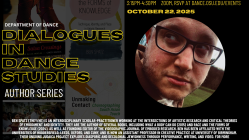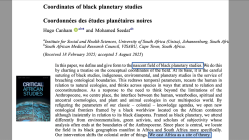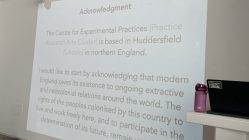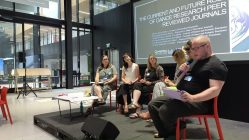“Sequence of Four Exercise-Actions” is a dense linear video document based on an extract from a session of physical training held at the Centre for Psychophysical Performance Research, University of Huddersfield (12 August 2015). The session was led by Ben Spatz, Senior Lecturer in Drama, Theatre and Performance, and is based on a form of physical training developed by Massimiliano Balduzzi, which Spatz previously documented and analyzed in Theatre, Dance and Performance Training 5:3. This training can be used to enhance a performer’s physical precision and sense of musicality as well as the ability to integrate dynamic movement with interpersonal awareness and imaginative associations. Also participating in the training session are Sobhia Jones (undergraduate alumna) and Chris Lomax (second year undergraduate).
In addition to sharing a moment of studio-based pedagogy and another glimpse of Balduzzi’s exercise-actions, the purpose of this video is to explore how layers of textual commentary and embedded video citation can increase the density of a video document to level appropriate for rigorous scholarship. The implicit argument is that scholarly videos should be to mainstream documentaries what scholarly monographs are to popular nonfiction books, i.e. more densely saturated with knowledge. Extending the argument put forward in the book What a Body Can Do: Technique as Knowledge, Practice as Research (2015), I demonstrate here how the field of embodied research can be supported by an approach to video documentation that focuses neither on the ephemerality of the live event nor on the specific formal qualities of video as a medium, but rather on how best to expose the density of specialized embodied practice.
The main video shows Spatz demonstrating solo work on a sequence of four exercise-actions. Jones can be seen matching Spatz’s rhythmic impulses while she observes from the side, while in the latter part of the video Lomax takes a turn in solo practice of the same sequence. Additional layers of epistemic density that provide contextualization and analysis of the core video include: textual annotation indicating the names of practitioners and exercises; textual references, as would commonly be founded in footnotes; embedded videos from other parts of the same training session, showing the layered density of technique within a given practice session; embedded videos and imagery from external sources, locating the documented practice in a wider epistemic context; textual commentary explicating all of the above; and continuous time code allowing others to make stable references to specific sections of this video.
Originally published by the Theatre, Dance and Performance Training blog.







[…] The video played in the middle is this one. […]
[…] One year later I produced a much denser video documenting a training session based on a ‘Sequence of Four Exercise-Actions‘ (4:19) developed by Massimiliano Balduzzi. This video juxtaposes textual commentary and […]